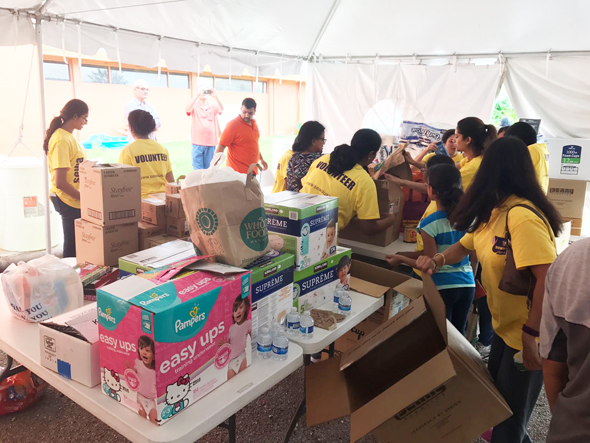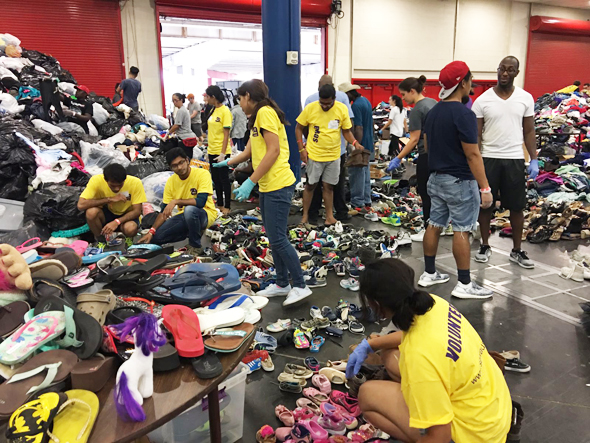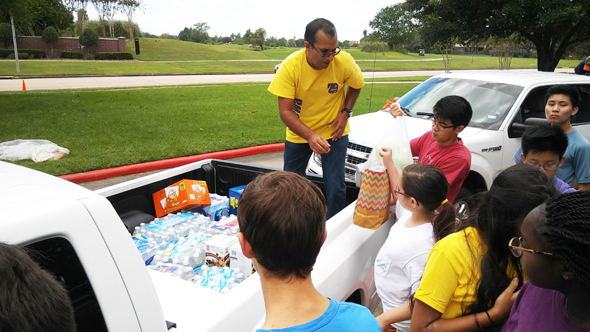An Equal Opportunity Disaster Hurts Communities Far and Wide
Saved under Charity, Community, Current Stories
Tags: Baytown, Clear Lake, Cypress, Desi news, Greater Houston, Houston, Houston Desi news, India, Indian American community, Indian News, Indians in America, Indo-American News, Katy, NRI, pearland, south asia, South India, Sugar Land, Texas, USA
By Jawahar Malhotra
HOUSTON: When Hurricane Harvey came onshore at Matagorda Bay and straight at Rockport, unleashing its Category 3 force winds on the area, it knocked down many structures and hovered there for a couple of days, but its fury didn’t really affect the Houston area. Two days later, we began to be pounded by Harvey’s dirty side, as band after band of rain clouds dumped four to six inches of rain an hour on the five counties that make up the greater Houston area.
Meteorologists had warned us that Harvey may stall and then twirl like a top before heading back out to the Gulf and launching a third landing (the first was over the Yucatan Peninsula) just east of Galveston. We marveled at the precision of their forecasts and stayed glued to the four major local tv channels for minute-by-minute reporting of how places and parts of the region we knew began to take on water and within a day, whole areas became rivers and began to resemble Venice with boats on wide major thoroughfares.
Had it not been for a rain band that moved ever so slightly to the east and provided an eight-hour lull in the downpour for a swath of the city on the westside from Freeport to Cypress, the area would have been easily far more inundated than it was and possibly many more people would have had their houses underwater. Though they caught a break, the city’s westside finally got its due when it was flooded – not by the rains, but on purpose – by the release of waters from the Addicks and Barker dams as the reservoirs became dangerously full, threatening people and dwellings on both sides.
Nearly 7 million people over a 17,000 square mile area felt the effects of torrential rains that brought in over 51 inches of water – trillions of gallons – over a three day period, more than what the entire region gets in a full year. The destruction that was left in wake was so complete that first responders and disaster relief crews were overwhelmed as areas that never had flooded before were now underwater.
Harvey’s destruction was widespread and covered the parts of the region where the Indian and South Asian community has settled over the past five decades. Some of the enclaves where they have made their homes – Sugar Land, Sienna Plantation, Missouri City, Aliana, Riverstone, Pearland, Friendswood, Meyerland, Memorial, Katy, Cypress, The Woodlands, Kingwood, Humble – all suffered evacuations and massive flooding.
Many a desi family was forced out either on their own or on boats and we saw their familiar faces on fleeting screen shots on tv or on social media. The storm affected people rich and poor alike and brought people together at evacuation shelters like never before. Businesses were closed and the effect on the local economy was measured in the billions.
This was the first hurricane that hit the region that was tracked so completely by social media as Facebook and WhatsApp lit up with reports by the minute of conditions all across the region. Several commonly used WhatsApp groups exploded with reports of evacuations and relief efforts and ad hoc virtual donation centers were set up. And the desi community opened its heart to everyone which was suffering. India House Executive Director Vipin Kumar was forced to evacuate his flooded house by boat. Anjali Center for Performing Arts building was completely damaged.
One group that set up two days before Harvey’s landfall was Seva International’s Houston Chapter. The multi-national organization relied on its experience in dealing with many natural disasters – most recently the massive floods last year in Chennai – to get their logistics assembled and relief camps deployed. Houston Chapter President Gitesh Desai’s house and two cars were flooded out and he was forced to evacuate but the teams continued to function, rescuing at least 683 people, according to area coordinator Vasudeva Singh. SI opened 15 WhatsApp groups and 15 Neighborhood groups of 150 people each. With over 800 volunteers, they spent over 20,000 volunteer hours helping people, served over 10,000 meals, and brought in 10 truckloads of food and supplies.
After the storm moved through other group sprang into action. Shiv Shakti Mandir held a massive donation and relief effort. Local area restaurants opened up their doors for free food to those who were now homeless. Madras Pavilion’s Rajan Radhakrishnan and Mahesh Shah dashed to the George Brown Convention Center to provide free meals to 650 people. Indian and International students from the University of Houston rushed to help with clean up. The Sikh National Center received trucks of supplies from across the country from other Sikh communities, as far away as Yuba City, California, according to spokesman Bhai Amar Singh. And a fund raising effort is underway to collect $1 million for rebuilding and relief efforts.
For the first time in 37 years, Indo American News missed a week of publication as its office location and staff were caught up in the flooding.




